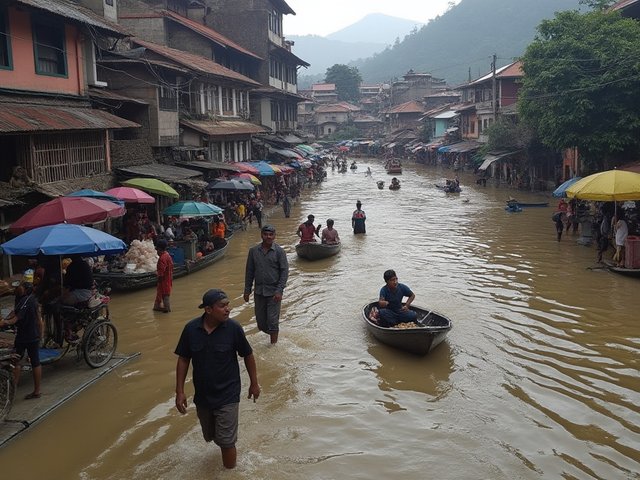Kathmandu Floods 2024: What Caused This Devastating Week of Rainfall?
Kathmandu Floods 2024: What Caused This Devastating Week of Rainfall?
In the last week of September 2024, Kathmandu, Nepal’s capital, was hit by an unprecedented and catastrophic flooding event, resulting from several factors combining to form a perfect storm. With more than 100 deaths reported across the country and dozens still missing, this disaster has reignited debates around urban planning, climate change, and Nepal’s preparedness for such natural calamities.
Record-Breaking Rainfall: Nature's Role in the Flood
The floods that devastated Kathmandu and surrounding areas began with relentless torrential rains starting on September 26, 2024. Over the course of 48 hours, the Kathmandu Valley saw over 240 mm (9.4 inches) of rain, the highest recorded since 1970. This amount of rain overwhelmed the city's rivers, including the Bagmati, Bishnumati, and Nakhu Rivers, which quickly rose beyond their banks. In many places, flash floods inundated entire neighborhoods, turning streets into rivers of debris and water. By the end of the week, over 100 people had lost their lives, with many more injured or missing.
The Bagmati River, which flows through the heart of Kathmandu, breached its banks, inundating low-lying areas of the city and sweeping away vehicles, homes, and infrastructure. Whole neighborhoods were left submerged, with thousands of residents displaced.
Meteorologists have attributed this event to a low-pressure system originating from the Bay of Bengal that moved northward and lingered over Nepal, dumping large amounts of moisture across the eastern and central parts of the country.
Unplanned Urbanization: A Human-Made Disaster?
While the torrential rain is undoubtedly a natural cause, experts argue that Kathmandu’s urban planning (or lack thereof) greatly amplified the impact of this flood. Over the past decades, Kathmandu has seen rapid urbanization, much of it haphazard and unregulated. The city has expanded onto floodplains, particularly along the banks of its rivers, leaving residents vulnerable when the waters rise.
Poorly designed drainage systems and the encroachment of informal settlements on riverbanks have worsened the situation. These rivers, which once had natural floodplains to accommodate excess water, are now choked by buildings, roads, and other structures. As a result, when heavy rainfall occurs, the water has nowhere to go but into the city’s streets.
Several experts have pointed out that Nepal’s disaster preparedness is lacking. The International Centre for Integrated Mountain Development (ICIMOD) has long warned about the dangers of unplanned urban growth in the region. They note that proper investment in flood prevention mechanisms—such as stormwater management systems, buffer zones along rivers, and early warning systems—could have significantly reduced the impact of this disaster.
Climate Change: Exacerbating Natural Disasters
The 2024 floods in Kathmandu are also a stark reminder of the growing influence of climate change on extreme weather patterns. Nepal has long been identified as one of the countries most vulnerable to climate change, and these floods demonstrate the destructive potential of erratic weather systems in the region.
Rising global temperatures have resulted in more frequent and intense monsoons in South Asia. In recent years, Nepal has experienced a higher number of extreme rainfall events, leading to devastating floods and landslides. Scientists fear that such incidents will only increase in the future as the effects of climate change become more pronounced.
The heavy rains of late September came at the tail end of the annual monsoon season, a period during which Nepal often experiences heavy rains. However, what made this event so extraordinary was the intensity of the rainfall over such a short period, which overwhelmed local infrastructure and emergency services.
Poor Infrastructure and Response Capabilities
Nepal’s infrastructure has long been a point of concern, with roads, bridges, and other critical infrastructure vulnerable to natural disasters. Landslides blocked major highways leading into and out of Kathmandu, cutting off access to aid and supplies for thousands of stranded travelers. Rescue efforts were further hampered by the inadequate equipment of Nepal's disaster response teams. Security forces such as the Nepal Army and the Armed Police Force were mobilized to aid in rescue operations, but many of their rescue tools, such as rubber boats and ropes, proved ineffective against the scale of the floods.
Nepal has also been criticized for its slow adoption of modern rescue techniques and equipment. Experts argue that outdated rescue methods, coupled with a lack of coordination between local and national government agencies, contributed to the high death toll. Furthermore, many flood-prone areas lacked early warning systems, which could have saved lives by alerting residents to the incoming danger.
Moving Forward: The Need for Better Preparedness
In the wake of the devastation caused by this week’s floods, many have called for a comprehensive overhaul of Kathmandu’s urban planning and disaster preparedness strategies. Better drainage systems, stricter enforcement of building codes, and investments in green infrastructure—such as wetlands and parks that can absorb floodwaters—are just some of the measures that could help mitigate future disasters.
This week’s floods in Kathmandu have underscored the urgent need for both climate action and infrastructure reform in Nepal. As the country continues to face the threat of more frequent extreme weather events, the government must take decisive steps to protect its citizens and prepare for a future where such natural disasters may become the norm.
Sources:
- Kathmandu Post
- Deutsche Welle (DW)
- International Centre for Integrated Mountain Development
- Wikipedia
